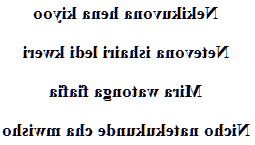Pare love poem
Kiyoo
Nekikuvona hena kiyoo
Netevona ishairi ledi kweri
Mira watonga fiafia
Nicho natekukunde cha mwisho


→ French poem ←
Asu language
My love poem translated into Asu (alternative names : Kipare, Pare, Pare-Asu, Ashu, Athu, Casu, Chasu, Chiasu, Kiathu).
Asu is the language of the Vaghonu and the Vaasu, that is to say of the Pare people, who live in northeastern Tanzania, in the mountainous region of the Pare mountains (between the Usambara mountains and Kilimanjaro), in the departments of Mwanga and Same, Manyara, Tanga and the Kilimanjaro region.
The region where this ethnic group lives, the country of Pare, is divided into two zones, north and south, respectively called Vughonu and Vuasu.
Their language asu is considered to have two main dialects, which are Mbaga and Gonja. In the north of Vuasu we can distinguish two groups: to the north that of the Ugweno who speaks Gweno, and to the south that of the Usangi who speaks the chasu.
This Bantu language, which is certainly the language of love, is spoken by 400.00 speakers. The Pares' close neighbors are the Chagas of Moshi and the Wadigo Wasambaa of Tanga.
Asu proverb: Bimanto ong’ee ni ufitha eti ndio dhahabu. - All that glitters is not gold.
The Pare; Bantu people
In the Pare villages, music occupies a very important place, it is present all day and accompanies the work; it is also considered an art. It takes part of course in the traditional rites where are called the spirits which influence all the daily.
Farmers and pastoralists, the Pares cultivate coffee, corn, rice and bananas, and their geographical location, on a commercial route to the Indian Ocean, allows them to sell some of their products.
The original cradle of this Bantu people is located in a region of western Cameroon, a region that they would have left four thousand years ago during the Bantu migrations. The colonial era then forced them to move from the lowlands of their region to the highlands.
The drying up of the Sahara during the Neolithic period led to the great migrations of the Proto-Bantus from the region between Niger and Oubangui, from the end of the 2nd to the 1st millennium BC.
Crossing the Pygmies' domain, they emerge into the south-Congo region, in the south of the great forest, driving back people who lived by hunting and picking.
They have a remarkable development in these savanna regions favorable to agriculture, because of their technical knowledge (particularly in the iron work), and because to their numerical superiority. They will irradiate everywhere in the south and the east, that why one finds them also in the Pare Mountains in Tanzania.